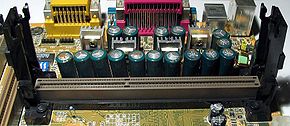Slot A
 | |
| Type | SECC |
|---|---|
| Chip form factors | PGA |
| Contacts | 242 |
| FSB protocol | EV6 |
| FSB frequency | 200 MT/s, 266 MT/s |
| Voltage range | 1.3–2.05 V |
| Processors | AMD Athlon (500–1000 MHz) |
| Predecessor | Super Socket 7 |
| Successor | Socket A |
This article is part of the CPU socket series | |
Slot A is the physical and electrical specification for a 242-lead single-edge-connector used by early versions of AMD's Athlon processor.[1]
The Slot A connector allows for a higher bus rate than Socket 7 or Super Socket 7. Slot A motherboards use the EV6 bus protocol, a technology originally developed by Digital Equipment Corporation (DEC) for its Alpha 21264 microprocessor.

Slot A is mechanically compatible but electrically incompatible with Intel's Slot 1. As a consequence, Slot A motherboards were designed to have the connector's installed orientation be rotated 180 degrees relative to Slot 1 motherboards to discourage accidental insertion of a Slot 1 processor into a Slot A motherboard, and vice versa. The choice to use the same mechanical connector as the Intel Slot 1 also allowed motherboard manufacturers to keep costs down by stocking the same part for both Slot 1 and Slot A assemblies.
Unlike with Slot 1 CPUs, there were never any converter cards, or slotkets made that allowed Socket A CPUs to be used on Slot A motherboards, as what happened with the slotkets made for using Socket 370 CPUs in Slot 1 motherboards.
AMD went back into using a traditional socket interface with Socket A in 2000.
Chipsets
[edit]AMD offered official chipsets for the Slot A CPUs. These are included in the table below.
| Model | Code name | Released | CPU support | FSB/HT (MHz) | Southbridge | Features / Notes |
|---|---|---|---|---|---|---|
| AMD-750 chipset | AMD-751 | August 1999[2] | Athlon, Duron (Slot A, Socket A), Alpha 21264[citation needed] | 50 (100MT/s) | AMD-756, VIA-VT82C686A | AGP 2×, SDRAM Irongate chipset family; early steppings had issues with AGP 2×; drivers often limited support to AGP 1×; later fixed with "super bypass" memory access adjustment.[3] |
Third-party chipsets includes a large number of VIA K-series chipsets.
In practice, third-party chipsets were heavily favoured by motherboard manufacturers. Stability problems and compatibility quirks from these chipsets abounded from manufacturers not following chipset designers' guidelines. This caused long-lasting damage to AMD's reputation, despite AMD having nothing to do with the poorly-realised hardware.[citation needed] A similar incident happened with third-party chipsets for Super Socket 7 CPUs, of which AMD tried to remedy it by putting quality assurance measures for the Athlon, which used Slot A CPUs. Despite this, however, the aforementioned problems mentioned above still lingered on for quite a while, even for Athlon CPUs.
See also
[edit]References
[edit]- ^ "CPU Sockets Chart". users.erols.com. Retrieved 2009-04-04.
- ^ "AMD-750 Chipset Overview" (PDF). AMD. Retrieved August 1, 2001.
- ^ Orozco, Silvino (December 29, 1999). "AMD's Super Bypass - AMD Improves their 750 Chipset". Tom's Hardware. Retrieved November 11, 2022.
